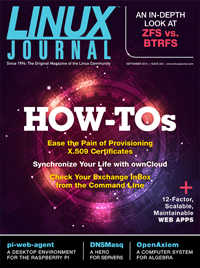September 2014 Issue of Linux Journal: HOW-TOs


How'd You Do That?
Open-source advocates tend to make for rotten magicians. Whereas most illusionists insist on taking their secrets to the grave, we tend to give away the secret sauce to anyone who'll listen. Heck, sometimes we create things just so we can explain to others how they work! And, that is how this issue was born. We love the How-To concept. Heck, our entire magazine is based on the idea of spreading knowledge, and this month, we specifically go out of our way to show not only the result, but the "How" as well.
Reuven M. Lerner starts us off with a discussion of 12-Factor Apps. He basically describes a process for developing scalable, maintainable Web applications. As someone who recently started creating Web apps, I can attest that they get unmanageable quickly! Dave Taylor follows with some smarter code for solving the "how many days have passed" script he's been working with for the past few months.
All too often, our perfectly crafted solutions get ruined by someone changing something outside our control. Kyle Rankin recently had an issue with his fetchmail setup, and he walks through the process of troubleshooting and problem solving when someone changes the rules. If, like me, you're a fan of Kyle's passion for the command line, you'll appreciate his efforts to maintain his ASCII lifestyle.
I made true on my promise to get a little more serious this month and wrote about DNSMasq. It's not a new program, but it's so powerful and so simple, it's often overlooked as a viable option for serving DNS and DHCP. Although most people are fine with running DNS and DHCP from their off-the-shelf routers, there are times when you need to run one or both of the services on a server. That's just what I needed to do, and I was pleasantly surprised at how powerful the little dæmon can be!
Much like car alarms, self-signed SSL certificates are all too often just accepted, especially on systems we're familiar with using. The problem is that if there is a compromise on one of our trusted systems, an invalid certificate might be the only warning we get. John Foley walks through the entire process for using PKI certificates. Whether you are an old hand at creating certs for VPNs or just copy/paste something from Google whenever you need to create a Web cert, his article is interesting and educational.
Last year you may recall I mentioned ownCloud as an alternative to Dropbox for those willing and able to host such a service on their own. Mike Diehl takes it to the next level with an incredible how-to on setting up, configuring and using ownCloud for all your cloud-based needs. At its core, ownCloud does indeed sync files, but it does so much more, it's worth taking a look at. And when it comes to file storage on your server, Russell Coker addresses another extremely important topic: data corruption. Using ZFS or BTRFS filesystems can protect your data, but which is better? Which should you choose? Russell answers all your questions and more.
If there's one product that fits into our How-To issue, it's the Raspberry Pi. It's the heart of just about every Linux-based DIY project on the Internet, and those little beauties run half the projects around my house as well. A quartet of authors (Vasilis Nicolaou, Angelos Georgiadis, Georgios Chairepetis and Andreas Galazis) give us a great description of pi-web-agent. Although the little RPi devices are incredible, they also are a bit intimidating for new Linux users. pi-web-agent changes that by providing a complete Web front end for managing and controlling the Raspberry Pi, making the RPi accessible to everyone!
If you've ever wanted to work with Linux, but weren't sure "how to" get started, this issue is for you. And if you're an old hat who wants to add more skills to your tech quiver? Again, for you too. To be honest, the entire Linux community is based on sharing information and collaborating ideas. There's no illusion at play, but there's plenty of magic!
Available to Subscribers: September 1










